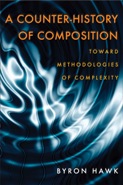A Counter-History of Composition: Toward Methodologies of Complexity
by Byron Hawk
U of Pittsburgh P, 2007, ISBN-10: 0-8229-5973-1
Reviewed by Wesley Venus, University of Georgia
| Summary | Discussion | Applicability | Pedagogy | Hopes/Desires | Conclusion(s) | Assessment | References | Notes |
Assessment |
|
 |
Because Hawk devotes the better part of A Counter-History of Composition to positioning the rhetorical canon of invention in a post-structural context, the book seems much better suited to a graduate seminar on rhetoric and historiography than to anything else. In time it could well become a mainstay in Composition Theory surveys, but since its praxis is scarce and when present is mostly about pedagogy, it does not seem suitable for a composition course at any level. Also, since the apparatus of it is so much a part of language and rhetorical theory, it might be better included as a supplementary text in a New Media theory survey in composition studies than as a primary one. For those interested in the interface and coding side of things, it’s not really their book, either. For scholars looking into the subject of vitalism, the book does take that doctrine as one of its few major commonplaces, so it will not function effectively at all as a primer in that regard. Hawk introduces the book with Kameen’s application of vitalism to composition and moves forward and backward to where it has appeared in composition studies scholarship. What foregrounding of vitalism he does provide can be found in the sections on Coleridge in Chapter Three and then Aristotle and the three kinds of vitalism in Chapter Four; but again, this information functions less to clarify than it does to further complicate the notion. One would not necessarily regard this as a weakness of the book, however, when considering that it is consistent with his argument on counter-method: the entry point to a rhetorical situation would begin with its present. Readers of Kairos will find A Counter-History of Composition of particular use to them as a book on theory and pedagogy that, once again, takes very little for granted otherwise. It does not address technology in detail until well into the last half, but along the way it establishes a context for it. The writing and technology community has long understood the correlation of digital technologies to the rhetorical features of modern mind, and that confidence certainly has been well documented. More than bringing the topic of vitalism back to feature it in the post-process discussion of writing and technology, however, A Counter-History connects readers with ideas from the past that were factors of language and rhetoric all along. With respect to the question of rhetorical theory’s role in relation to rhetorical practice, a book more relevant could hardly be found.
|